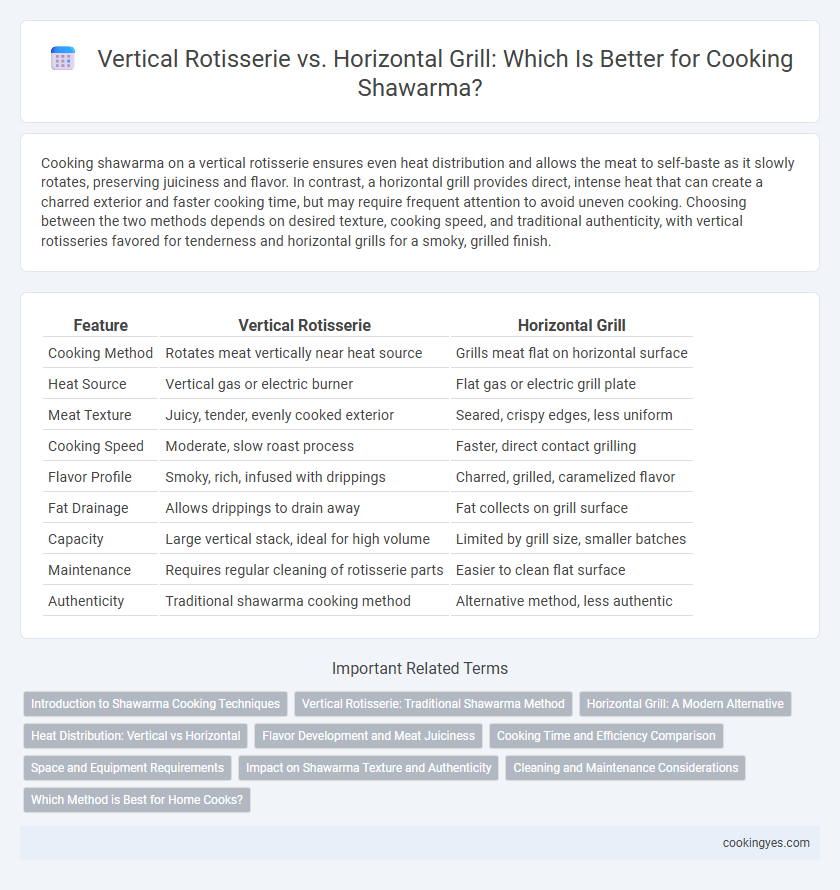Cooking shawarma on a vertical rotisserie ensures even heat distribution and allows the meat to self-baste as it slowly rotates, preserving juiciness and flavor. In contrast, a horizontal grill provides direct, intense heat that can create a charred exterior and faster cooking time, but may require frequent attention to avoid uneven cooking. Choosing between the two methods depends on desired texture, cooking speed, and traditional authenticity, with vertical rotisseries favored for tenderness and horizontal grills for a smoky, grilled finish.
Table of Comparison
| Feature | Vertical Rotisserie | Horizontal Grill |
|---|---|---|
| Cooking Method | Rotates meat vertically near heat source | Grills meat flat on horizontal surface |
| Heat Source | Vertical gas or electric burner | Flat gas or electric grill plate |
| Meat Texture | Juicy, tender, evenly cooked exterior | Seared, crispy edges, less uniform |
| Cooking Speed | Moderate, slow roast process | Faster, direct contact grilling |
| Flavor Profile | Smoky, rich, infused with drippings | Charred, grilled, caramelized flavor |
| Fat Drainage | Allows drippings to drain away | Fat collects on grill surface |
| Capacity | Large vertical stack, ideal for high volume | Limited by grill size, smaller batches |
| Maintenance | Requires regular cleaning of rotisserie parts | Easier to clean flat surface |
| Authenticity | Traditional shawarma cooking method | Alternative method, less authentic |
Introduction to Shawarma Cooking Techniques
Vertical rotisseries evenly cook shawarma by rotating marinated meat slices, allowing fat to baste the meat naturally and produce tender, juicy layers. Horizontal grills expose meat directly to heat, creating a charred texture but may result in uneven cooking and moisture loss. Choosing between vertical rotisserie and horizontal grill affects flavor profile, texture, and traditional authenticity of shawarma.
Vertical Rotisserie: Traditional Shawarma Method
The vertical rotisserie remains the traditional method for cooking shawarma, offering even heat distribution that ensures tender, juicy meat while allowing excess fat to drip away, enhancing flavor and texture. This technique maintains consistent temperature control, which helps in slow roasting the marinated meat layers, preserving their moisture and distinctive spices. Compared to horizontal grills, vertical rotisseries provide authentic shawarma with a signature outer crispiness and inner succulence, integral to its iconic taste.
Horizontal Grill: A Modern Alternative
Horizontal grills provide even heat distribution and faster cooking times for shawarma meat, resulting in juicier and more evenly cooked slices. This modern alternative to the traditional vertical rotisserie allows for greater control over temperature and flame intensity, enhancing flavor development through direct contact with the grill surface. Horizontal grilling also reduces fat dripping away, preserving moisture and yielding a tender, flavorful shawarma experience.
Heat Distribution: Vertical vs Horizontal
Vertical rotisseries provide even heat distribution by rotating meat slowly in front of a consistent heat source, allowing fat to baste the layers naturally and resulting in uniform cooking. Horizontal grills offer direct, intense heat that can create charred edges quickly but may cook unevenly, requiring manual turning to avoid overcooking or undercooking certain sections. Efficient heat management in vertical rotisseries enhances juiciness and texture, while horizontal grills emphasize caramelization and crispness on the meat's surface.
Flavor Development and Meat Juiciness
Vertical rotisseries enhance shawarma flavor development by allowing continuous self-basting as the meat rotates, preserving its juices and creating a crispy outer layer with tender, juicy interior slices. In contrast, horizontal grills provide direct heat that can lead to uneven cooking and potential moisture loss, often resulting in drier meat with less complex flavor profiles. The vertical rotisserie method significantly improves meat juiciness and aromatic depth, making it the preferred technique for authentic shawarma preparation.
Cooking Time and Efficiency Comparison
Vertical rotisseries cook shawarma evenly by rotating meat slices slowly around a heat source, reducing cooking time through consistent exposure to radiant heat. Horizontal grills require manual turning and may cook less uniformly, often resulting in longer cooking times and lower energy efficiency. Vertical rotisseries are widely favored for optimal efficiency, faster cooking cycles, and better retention of moisture and flavor in shawarma preparation.
Space and Equipment Requirements
Vertical rotisseries for shawarma cooking require less floor space and allow for efficient vertical stacking of meat, optimizing kitchen layout in small or busy environments. In contrast, horizontal grills demand more countertop area and specialized ventilation systems to manage smoke and grease, increasing overall space and maintenance needs. Selecting between vertical or horizontal equipment hinges on available kitchen space and intended cooking capacity, impacting operational workflow and equipment footprint.
Impact on Shawarma Texture and Authenticity
Vertical rotisserie cooking for shawarma ensures even fat distribution and slow roasting, producing tender, juicy meat with a characteristic smoky flavor essential for authenticity. In contrast, horizontal grills risk uneven cooking and moisture loss, resulting in a drier texture and less traditional taste. The vertical method preserves the unique layers and succulence that define classic shawarma texture and flavor.
Cleaning and Maintenance Considerations
Vertical rotisseries for shawarma cooking offer easier cleaning due to their upright design, allowing grease and drippings to collect in a tray, minimizing mess and reducing residue buildup. Horizontal grills require more frequent disassembly and scrubbing since grease distributes unevenly and can accumulate on flat surfaces, increasing maintenance time. Stainless steel vertical rotisseries also resist corrosion better, leading to lower long-term upkeep compared to horizontal grilling units.
Which Method is Best for Home Cooks?
Vertical rotisserie cooking for shawarma offers consistent heat distribution and self-basting as juices drip down, making it ideal for tender, flavorful meat at home. Horizontal grills provide more control over direct heat and searing but can result in uneven cooking and require constant attention. For home cooks seeking convenience and authentic texture, vertical rotisserie is generally the better choice.
Vertical rotisserie vs horizontal grill for shawarma cooking Infographic

 cookingyes.com
cookingyes.com